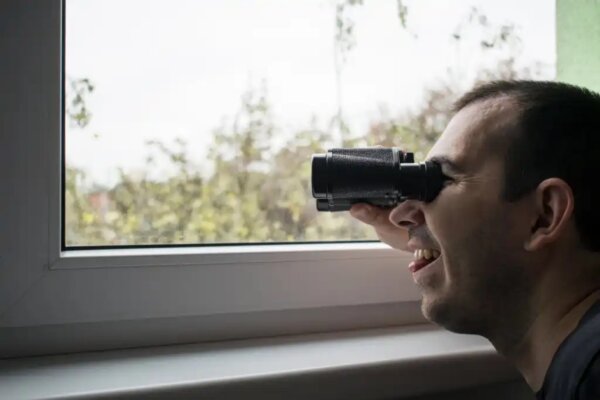Voyeurism isn't the Same as Voyeuristic Disorder

Not everyone likes or gets aroused by the same things. A paraphilia is sexual arousal in unusual situations or activities. However, when these activities involve harm or suffering to others, we call them paraphilic disorders. Voyeurism is a paraphilia.
We need to differentiate between voyeurism, which is a non-pathological paraphilia, and voyeuristic disorder, which is a paraphilic disorder. Voyeurism consists of observing other people getting naked, getting undressed, or having sex. However, voyeuristic disorder is a paraphilic disorder. Paraphilic disorders are conditions where the individual acts on their urges with a non-consenting person, Furthermore, they suffer discomfort and distress themselves due to these urges.
The DSM-5 (Diagnostic and Statistical Manual of Mental Disorders) states that the prevalence of voyeurism is unknown. However, according to non-clinical samples of voyeuristic sexual acts, the highest possible prevalence of the disorder is 12 percent for men and four percent for women.

Paraphilia and paraphilic disorders
The DSM-5 states that voyeurism is a form of paraphilia. It defines paraphilia as “frequent and intense sexually arousing fantasies of behaviors that involve inanimate objects, children, or non-consenting adults”. However, paraphilic disorder implies a psychological condition. The DSM-5 states that paraphilia isn’t a mental disorder in itself. Although paraphilia is a necessary component, it isn’t sufficient on its own to be classified as a paraphilic disorder.
In principle, paraphilia doesn’t automatically warrant clinical intervention. As we mentioned above, a paraphilic disorder involves the individual causing suffering or harming themselves or others to satisfy their urges.
Voyeurism may develop into voyeuristic disorder
As we stated above, voyeurism is a kind of paraphilia. However, if it develops into voyeuristic disorder, it’s classified as a paraphilic disorder. This affects the functioning of the individual in daily life. In everyday life, people incorrectly use the terms paraphilia and paraphilic disorder interchangeably. In this article, we’ll explain voyeuristic disorder.
Voyeuristic disorder
The DSM-5 specified the diagnostic criteria for voyeuristic disorder:
Excitation derived from observing others
For at least six months, the individual has been repeatedly and intensely aroused by observing an unsuspecting person naked, undressing, or engaging in sexual activity.
This excitement manifests itself in the form of fantasies, intense urges, and behaviors.
Non-consent
Individuals act on their urges with a non-consenting person. These fantasies, intense urges, and behaviors cause the sufferer significant distress. In fact, it may impair their functioning at work, in social situations, or in other important areas of their lives.
Age
Individuals can’t be diagnosed with voyeuristic disorder until they’re at least 18 years old.

Voyeurism in the ICD-10
The ICD-10 (International Classification of Diseases) also recognizes voyeurism. It describes it as:
- A disorder characterized by recurrent sexual urges, fantasies, or behaviors involving observing an unsuspecting person naked, disrobing, or engaging in sexual activity.
- A paraphilia characterized by repetitive looking at unsuspecting people, usually strangers, naked, in the act of disrobing, or engaging in sexual activity to achieve sexual arousal.
Voyeurism or voyeuristic disorder
In cases of voyeurism, the individual experiences the persistent inclination to watch others performing sexual or intimate activities. These include undressing and having sex. When they observe these kinds of situations, they get aroused and masturbate. However, generally, they have no desire to actually have sexual intercourse with those they’re watching.
What excites the person is watching others have sex. However, they have no desire to have sex with them.
Voyeurism isn’t the disease but the pleasure or excitement someone feels when they observe others (usually without their knowledge) undressing or having sex. However, as we’ve seen in this article, voyeurism may develop into voyeuristic disorder. Then, it can cause suffering in both the individual and the others involved.
“Sex is a part of nature. I go along with nature.”
-Marilyn Monroe-
All cited sources were thoroughly reviewed by our team to ensure their quality, reliability, currency, and validity. The bibliography of this article was considered reliable and of academic or scientific accuracy.
- American Psychiatric Association –APA- (2014). DSM-5. Manual diagnóstico y estadístico de los trastornos mentales. Madrid: Panamericana.
- Belloch, A., Sandín, B. y Ramos, F. (2010). Manual de Psicopatología. Volumen I y II. Madrid: McGraw-Hill.
- OMS: CIE-10. (1992). Trastornos Mentales y del Comportamiento. Décima Revisión de la Clasificación Internacional de las Enfermedades. Descripciones Clínicas y pautas para el diagnóstico. Organización Mundial de la Salud, Ginebra.
This text is provided for informational purposes only and does not replace consultation with a professional. If in doubt, consult your specialist.








